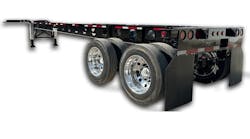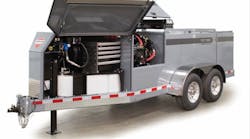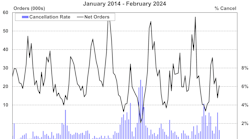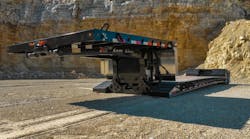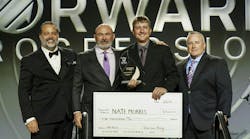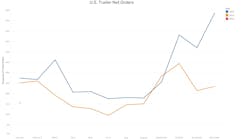A trailer parts department has to be able to measure everything it does, because it can't improve what it can't measure, according to Keith Ely, managing partner of Keith Ely & Associates.
In a National Trailer Dealers Association (NTDA) webinar, “Operations Excellence for Parts Departments:Maintaining and Increasing Parts Market Share in a Down Economy,” Ely said traditional financial accounting measures can give misleading signals if a company doesn't dig down to the leading indicators.
“Traditional measures do not indicate how well the dealership is doing in the areas of customer service, continuous improvement, and innovation — all key factors in today's highly competitive marketplace,” he said. “In order to measure both financial performance and other areas of business performance, a manager needs a ‘balanced’ presentation of both financial and operational (non-financial) measures.
“Profitability doesn't equal cash. Cash is the most important piece of any business. If you don't have cash, even if you're making all the profit in the world, if you're not collecting receivables and turning inventory, you won't have cash and can't pay the bills.”
He gave the example of a dealership that has stock in hand 60 days on average before it's sold.
“When they bought the stock, they had 30 days to pay for it,” he said. “From the time we sell it, this dealership was taking 80 days to collect the receivable. That means we have a cash gap, which is a time period from the time we laid out money to pay for the part until we get paid for it. In this case, the cash gap is 100 days — a long time for a dealership to go without cash. The more we can lower the cash gap, the lower our cost of doing business.”
Ely said “fixed absorption” is the ability of the fixed operations departments (service, parts, and body shop, as a total effort) to create enough gross profit to pay for all the expenses created by the entire dealership, other than commissions paid to trailer salespersons.
The total fixed gross profit is divided by expenses. Remove new and used sales commissions, new and used policy expenses (work done after the sale of trailer that's covered by the dealership and given as a goodwill feature to the customer.) Also remove any delivery expenses for new and used trailer sales. That provides the adjusted overhead expense. Take the fixed gross profit and divide that by the adjusted overhead expenses to get the total dealership absorption.
“Our goal is at least 100%, and preferably 110% or more,” Ely said. “The higher this number is, the more flexible we can be as parts managers and GMs. If we're under 100%, we're cramped in our ability to lower margins and really cramped in our ability to get rid of excess inventory, in particular used equipment.
“Absorption does not tell asset information — we can be selling all day long with strong gross profit but not collecting anything, and go out of business — nor does it tell cash-position information.”
Mature industry
He said the dealership industry is a mature industry with several characteristics:
- Slow to no growth in real total-market terms
“We're not talking about the trailer market. We're talking about the American economy, the GDP. When you're talking about the last 15 years, you see spikes in trailer sales and parts, but you also see slowdowns. We've seen that if you compare the average year of trailer sales to the average year of economic growth, it's actually less than the total margin. People are much more efficient with these assets than they used to be. So it's growing slower than what the real market is. Because of that, the buyers are experienced. In terms of the size of the economy, the number of buyers is less.”
- Pricing is competitive
“That's because the products aren't differentiated.”
- Success in a mature industry is based on a cost structure that is lower than what our competitors are
“Our service has to be better. In the last 18 months, we've seen cost structures decrease.”
He said success points include: inventory integrity (have the right amount of parts on-hand for demand); the cost per transaction must be lowered (it provides pricing flexibility); customer service is key (understand why and when a customer buys); and pricing strategies are needed (movement, competitive, proprietary).
The goals are to achieve inventory integrity, protect the base, drive incremental gross profit, lower transaction cost, and improve inventory true turns and aging.
“We would like 85% of our parts to be no older than six months on the shelf,” he said. “When we get to a part that's nine months old, the probability of selling it is only 15%.”
His inventory management practice implementation includes an analysis of three key items in order to have high turns and a high fill rate:
-
On-hand accuracy.
-
Outside purchases. “Why do we buy parts from outside vendors?”
-
Lost sales. ”Why did we have somebody request a part and we didn't have it in stock?”
He said there should be monthly reconciliation between accounting and physical inventory, because if a company allows a year to pass in between physicals, it's almost impossible to find the variants. Lost sales need to be accurately recorded and tracked.
“Almost every computer system tracks sales, but we've found that isn't the best method,” he said. “It's the yellow pad. Write down every lost sale — a part that is requested that is not in our inventory. We may special order that part. It is still a lost sale from the inventory because we did not have inventory on hand. The counter person records it, it goes to the parts manager on a daily basis and they enter it into the system. We get control over lost sales, rather than counter people entering them into the system. Outside purchases have to be accounted for accurately, both from an accounting and data-entry standpoint into the system.”
Good practices
He listed some good inventory-management practices:
-
Bin checks/perpetual inventory must be done daily.
-
Each bin should be counted on average three to four times per year, with the company determining how to do that.
-
All plus/minus adjustments need to be verified daily. The totals need to be given to accounting at the end of the month, with the cost of adjustments.
-
Inventory pricing adjustments (price tape) must be accounted for monthly on the general ledger.
-
Special order parts must be managed appropriately. They need to be sold to people ordering them. “It doesn't do any good to special-order a part and have it sit in the will-call shelf. Pre-paid special order part is by far the best method to go if you can do it.”
-
Returns must be used to the fullest capacity.
-
Reconcile customer/emergency purchases as to “why.” “Every single day, ask, ‘Why did we order this part for this customer? Why was it not in stock?’ Understand why you're not bringing a part into stock or why it is out of stock. This is very labor intensive, but by doing it, parts that are requested start being in stock.”
He said phase-in/out should determined by source, type, vendor, seasonality, and what impacts the phase-in/out.
“Is it a fast-moving or seasonal part?” he said. “Typically when we work with a dealer, we find that this area is lacking. When the computer system was set up, they just copied over what had been done historically. That's not good enough today.”
He offered pricing strategies:
- Protect the base
“We have a bank of customers where we don't want to impact their pricing. We don't want to go out and play with pricing if they're buying lot of parts from us. We also don't want to impact demand on parts we're selling. We're willing to pick up incremental gross profit dollars.”
- Gross-profit percentage will be impacted
“However, we're looking for more gross profit, more incremental gross-profit dollars without giving anything up on the base. We'll take the gross-profit percentage being lower because you can't spin percentages. We want more gross-profit dollars without more expense.”
- Trailer down versus non-trailer down
“If it's a trailer down part, we can get more money gross profit-wise because if somebody needs a trailer now, they're willing to pay more for it.”
- Proprietary versus competitive
“If it's proprietary, we can price higher. Are we the only game in town for this type of part? If that's the case, you can sell it for more. If it's competitive, we need to understand the market.”
Outside parts sales require an account analysis, featuring a fleet analysis of the units and key metrics, determining whether it's cost per mile or a maintenance interval.
“It should include total dollars purchased from the dealership and competitors: What are they buying? And why are they not buying from us?” he said. “What types of parts are purchased? What is important to the customer in terms of availability, price, delivery, and communication?
“In the assignment of the outside parts salesperson, what is the potential of the account? We think the salesman can handle no more than 75 accounts. That may change for your market area. If you are a truck dealer handling a Waste Management in your area, and it had 10 locations, Waste Management may be your only customer as an outside parts salesperson.
“How many locations of a customer are there in the market area? How many accounts can a salesman manage?
What about phone support, technology, and delivery? What OE assistance can we get? We need to use them for combined sales calls, vendor nights, and bulk purchases.”
“What is the current fleet status? What parts will be needed to bring the fleet back up to running capability? When does the fleet expect utilization of fleets to start increasing? The key is, be in constant touch with fleets, understanding what they need, why, and when.”
He said Ely & Associates is working with customers on a direct link on an Ecommerce site to order parts. It's not a retail site, but is used for stock orders and special orders with major accounts. The site is integrated with the Dealer Management System (DMS).
“It reduces steps in the process,” he said. “It looks to see if a part is in stock, converts it into a special order, and automatically places the order. If it's a stock order and on hand, it will print a pick ticket so the stock order can be picked. It cuts costs down in the process. One of our customers cut their cost by $7.34 per transaction, and they do a tremendous number of transactions. They were able to achieve profit on customers they had been break-even on.
“We found that you can adjust pricing if needed, because it lowers the cost of the transaction. If you want to or need to adjust pricing to drive business through the website, it can be done and you can lower it.”
He said Ely & Associates' Balanced Scorecard helps parts departments develop a dealership strategy and group/branch/department profile, identify objectives, develop measures, prepare a strategy map to clarify logic, develop goals and action plans to achieve objectives and develop measurement reporting.
Four areas are analyzed:
- Strengths (internal)
“What things are we uniquely and exceptionally good at and are customer-valued? It could be products, people, a variety of things.”
- Weaknesses (internal)
“What are we uniquely bad at — things that customers don't like that we're bad at? They do not have to do with competition.”
- Opportunities (external)
“Items in the marketplace where we have the opportunity for growth to improve performance. It could be the competition going out of business or a customer looking to change.”
- Threats (external)
“Things we have little or no control over. We need to recognize they are there: economic factors, OE issues, marketplace issues, customers going out of business.”
“When we do this, we see a return on investment, if they follow the Balanced Scorecard Approach, in excess of 250%.”
